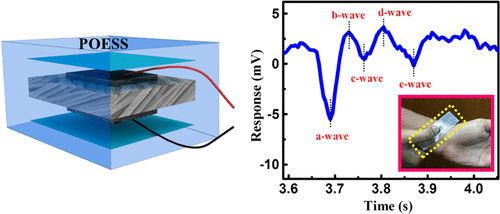当前位置:
X-MOL 学术
›
ACS Appl. Polym. Mater.
›
论文详情
Our official English website, www.x-mol.net, welcomes your
feedback! (Note: you will need to create a separate account there.)
Self-Powered Human-Health Monitoring through Aligned PVDF Nanofibers Interfaced Skin-Interactive Piezoelectric Sensor
ACS Applied Polymer Materials ( IF 4.4 ) Pub Date : 2020-01-28 , DOI: 10.1021/acsapm.9b00846 Kuntal Maity 1 , Samiran Garain 1, 2 , Karsten Henkel 2, 3 , Dieter Schmeißer 2 , Dipankar Mandal 1, 4
ACS Applied Polymer Materials ( IF 4.4 ) Pub Date : 2020-01-28 , DOI: 10.1021/acsapm.9b00846 Kuntal Maity 1 , Samiran Garain 1, 2 , Karsten Henkel 2, 3 , Dieter Schmeißer 2 , Dipankar Mandal 1, 4
Affiliation

|
Flexible and wearable e-skin sensors are attracting a great interest for their smart sensing applications in next-generation electronics. However, implant ability, sensitivity, and biosignal detection capability in a self-powered manner are the prime concerns in embedded devices. In particular, electrode compatibility and imperishability have become challenging issues in wearable sensors due to the poor compatibility and fragileness of metal electrodes. In this context, we report on a skin-interactive metal-free spongy electrode in a piezoelectric sensor where highly aligned poly(vinylidene fluoride) (PVDF) nanofibers (NFs) arrays are introduced as the piezoelectric active component and conducting polyaniline- (PANI-) coated PVDF (PANI–PVDF) NFs mats served as flexible electrodes. Notably, a 99% yield of piezoelectric phases of the aligned PVDF arrays is the key factor to exhibit promising mechano-sensitivity (0.8 V/kPa) performance that in turn helps in human-health monitoring. The sensor shows excellent mechanical to electrical energy conversion that enable to sense human finger touch (10 V under 10 kPa) with energy conversion efficiency of 53%. Most importantly, due to the compatible electrodes excellent mechanical stability has been found showing negligible degradation over 12,000 periodic cycles. Furthermore, under mechanical stimuli, it is also possible to charge up a capacitor (1 μF) to 4 V within 60 s confirming the possibility to use the device as a self-powered piezo-organic-e-skin sensor (POESS). This type of structural design enables to trace elusive movement of muscles and the operation in several conditions such as bending, compression and stretching. We demonstrated various human gestures monitoring, such as wrist bending, neck stretching, and arm compressions, throat movements during drinking water, coughing actions, and swallowing. In addition, diverse specific phonation recognition, heart-pulse measurement and its respective short-time Fourier transform (STFT) analysis indicate an efficient and convenient way of monitoring human-health status particularly in hospital-free mode.
中文翻译:

通过对齐的PVDF纳米纤维与皮肤互动式压电传感器接口的自供电人体健康监测
柔性和可穿戴电子皮肤传感器对其在下一代电子产品中的智能传感应用引起了极大的兴趣。然而,以嵌入式方式实现的植入能力,灵敏度和生物信号检测能力是嵌入式设备的主要考虑因素。特别地,由于金属电极的差的相容性和易碎性,电极的相容性和不透气性已经成为可穿戴传感器中的挑战性问题。在此背景下,我们报告了一种压电传感器中的无皮肤互动性金属海绵状电极,其中引入了高度取向的聚偏二氟乙烯(PVDF)纳米纤维(NFs)阵列作为压电活性成分并传导聚苯胺-(PANI- )涂覆的PVDF(PANI–PVDF)NF垫用作柔性电极。值得注意的是 对齐后的PVDF阵列的压电相的99%的产率是展现出有前途的机械敏感性(0.8 V / kPa)性能的关键因素,进而有助于人类健康监测。该传感器具有出色的机械到电能转换能力,能够感应人的手指触摸(10 kPa下为10 V),能量转换效率为53%。最重要的是,由于使用了兼容的电极,已经发现优异的机械稳定性在12,000个周期内显示出可忽略的退化。此外,在机械刺激下,还可以在60 s内将一个电容器(1μF)充电至4 V,从而确认可以将该设备用作自供电的压电有机皮肤传感器(POESS)。这种类型的结构设计能够跟踪肌肉的难以捉摸的运动以及在诸如弯曲,压缩和拉伸等几种情况下的操作。我们演示了各种人体手势监控,例如手腕弯曲,颈部拉伸和手臂压缩,饮用水中的喉咙运动,咳嗽动作和吞咽。此外,各种特定的发声识别,心脏脉冲测量及其相应的短时傅立叶变换(STFT)分析,特别是在无医院模式下,提供了一种监测人类健康状况的有效便捷方法。
更新日期:2020-01-29
中文翻译:

通过对齐的PVDF纳米纤维与皮肤互动式压电传感器接口的自供电人体健康监测
柔性和可穿戴电子皮肤传感器对其在下一代电子产品中的智能传感应用引起了极大的兴趣。然而,以嵌入式方式实现的植入能力,灵敏度和生物信号检测能力是嵌入式设备的主要考虑因素。特别地,由于金属电极的差的相容性和易碎性,电极的相容性和不透气性已经成为可穿戴传感器中的挑战性问题。在此背景下,我们报告了一种压电传感器中的无皮肤互动性金属海绵状电极,其中引入了高度取向的聚偏二氟乙烯(PVDF)纳米纤维(NFs)阵列作为压电活性成分并传导聚苯胺-(PANI- )涂覆的PVDF(PANI–PVDF)NF垫用作柔性电极。值得注意的是 对齐后的PVDF阵列的压电相的99%的产率是展现出有前途的机械敏感性(0.8 V / kPa)性能的关键因素,进而有助于人类健康监测。该传感器具有出色的机械到电能转换能力,能够感应人的手指触摸(10 kPa下为10 V),能量转换效率为53%。最重要的是,由于使用了兼容的电极,已经发现优异的机械稳定性在12,000个周期内显示出可忽略的退化。此外,在机械刺激下,还可以在60 s内将一个电容器(1μF)充电至4 V,从而确认可以将该设备用作自供电的压电有机皮肤传感器(POESS)。这种类型的结构设计能够跟踪肌肉的难以捉摸的运动以及在诸如弯曲,压缩和拉伸等几种情况下的操作。我们演示了各种人体手势监控,例如手腕弯曲,颈部拉伸和手臂压缩,饮用水中的喉咙运动,咳嗽动作和吞咽。此外,各种特定的发声识别,心脏脉冲测量及其相应的短时傅立叶变换(STFT)分析,特别是在无医院模式下,提供了一种监测人类健康状况的有效便捷方法。











































 京公网安备 11010802027423号
京公网安备 11010802027423号